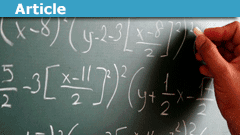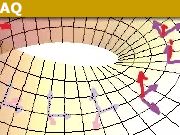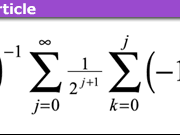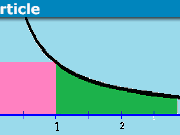An Intro on Real Numbers and Real Analysis
It is important to realize that in standard mathematics, we attempt to characterize everything in terms of sets. This means that notions such as natural numbers, integers, real and rational numbers are defined in mathematics to be certain sets. Also, the very notion of a function is defined as a set.
Why is this done this way? Obviously, a real number is not a set in our real life, so why do mathematicians define it in terms of sets? In order to understand this, one must go back to the origins of mathematics. One of the first successful theories of mathematics was Greek geometry. The Greeks thought however that every number is either natural or rational. The discovery that ##\sqrt{2}## is not a fraction of two natural numbers was very disturbing to the Greeks. This caused a division between algebra and geometry. Algebra was seen by the Greek mathematicians to be unreliable and lead to paradoxes. Geometry however was pure. The Greek geometers relied on certain axioms in order to define their geometry. It is important to realize that those axioms were seen to be true statements about the real world.
It took a long time – until the 19th century – for mathematicians to realize that there were other geometries. Hyperbolic geometry was very alike Greek Euclidean geometry, but also had a lot of important differences. It was realized that perhaps space did not behave Euclidean (a fact that was confirmed later by Einstein’s theory of relativity!). So what was the justification then for Euclid’s axioms? We cannot say anymore that they are obvious statements about the real world. The alternative would be that it is a system invented by the mind.
But if Euclidean geometry is invented by the mind, then how are we so sure it is consistent? How are we sure that we can accept these axioms and that no paradox would arise? We can’t. So even the very pure geometry was seen to be flawed. And with it, every result in Euclidean geometry was suspect since its axioms could be paradoxical.
The idea of the 19th century was to base mathematics on something different than geometry. The idea was to base mathematics on sets. It was seen that the real numbers could be constructed out of rational numbers. So if the rational numbers form a nice consistent system, then there was no problem for the reals either. The rational numbers can be constructed out of the integers. So if the integers are a consistent system, then the rational numbers are too. The integers can be constructed out of natural numbers. So again, if the natural numbers are consistent, then so are the integers. The consistency of the natural numbers was more difficult, but it was seen to be possible to define natural numbers using only sets. So if the entire theory of sets is consistent, then so are the natural numbers.
And this is where the good news ends. The incompleteness proof by Gödel showed that it is impossible to demonstrate the consistency of set theory in itself. Nevertheless, most mathematicians do not doubt that set theory is in fact a consistent system, we just are unable to prove it.
What to make of all those construction results then? They are important because defining real numbers or natural numbers in terms of sets means that we have to take less for granted. If we didn’t have those definitions in terms of sets, it would mean that outside of set theory, we would also have to have a consistent theory of real numbers. Defining reals in terms of sets makes our life easier in that sense.
Note that the construction does not tell us what real numbers really are! A real number such as ##\sqrt{2}## is not a set in our mind, since we like to think of it as a point on a real number line. All that the construction of ##\mathbb{R}## tells us is that we can at least model something that looks like ##\mathbb{R}## inside set theory. Whether that something really is ##\mathbb{R}## or not is a philosophically difficult question. But mathematicians don’t care. Mathematicians only care about the properties of an object. So if the set-theoretic model of ##\mathbb{R}## behaves exactly like ##\mathbb{R}##, then it IS ##\mathbb{R}## to a mathematician.
It might be a good idea to say how exactly functions are modeled in set theory. First we begin with the ordered pair ##(a,b)##. This ordered pair is defined as
$$(a,b)=\{\{a\},\{a,b\}\}$$
This definition satisfies the important property ##(a,b) = (a’,b’)## if and only if ##a=a’## and ##b=b’## (Prove it!). And again, this is enough for the mathematician, since that property tells us exactly how the object behaves. A mathematician doesn’t care whether the ordered pair really IS the thing we have defined above (I would say it’s not), but a mathematician only cares that it has the same properties of the ordered pair. And it does, so the mathematician is happy. The rest must be left to philosophers.
Note that is is then possible to define ordered ##n##-tuples by setting ##(a,b,c) = ((a,b),c)## and ##(a,b,c,d) = ((a,b,c),d)## and so on. This again behaves like we expect it to.
A function ##f## between sets ##A## and ##B## is denoted as ##f:A\rightarrow B##. It is defined as the ##3##-tuple ##(A,B,R)##, where ##R## is a subset of ##A\times B= \{(a,b)~\vert~a\in A,b\in B\}##. In order for this to be a function it must satisfy the condition that for each ##a\in A##, there is a unique ##b\in B## such that ##(a,b)\in R##.
For example, take the function ##f:\mathbb{R}\rightarrow \mathbb{R}:x\rightarrow x^2##. This function is formally given by
$$(\mathbb{R},\mathbb{R},\{(x,x^2)~\vert~x\in \mathbb{R}\})$$
So we see a function as “given” if we know its domain, its codomain and its graph. Indeed, if we use the shorthand ##b =f(a)##instead of ##(a,b)\in R##, then we see that two functions ##f = (A,B,R)## and ##g = (A’,B’, R’)## are equal if and only if ##A=A’##, ##B=B’## and for each ##a\in A## we have ##f(a) = g(a)##. This result is exactly the goal of our definition.
Notice that a function is intuitively seen as a kind of “process” or “change” in the sense that a function transforms an input to an output. In mathematics, a function is just a set that relates input variables to output variables. It is important to realize that the mathematical definition doesn’t tell us what a set really is. What a set really is, depends on your philosophical view. The mathematical definition merely tells us how to model the intuitive “function concept” in terms of set theory only. This model behaves the way we want it to behave and the mathematician desires nothing more than that.
Advanced education and experience with mathematics








Leave a Reply
Want to join the discussion?Feel free to contribute!